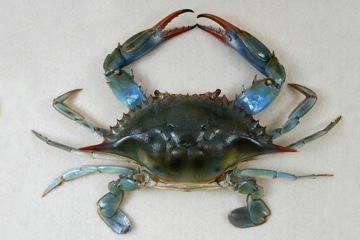Callinectes sapidus (from the Greek calli- = “beautiful”, nectes = “swimmer”, and Latin sapidus = “savory”), the Chesapeake or Atlantic blue crab, is a crustacean found in the waters of the western Atlantic Ocean, the Pacific coast of Central America and the Gulf of Mexico. On the Pacific coast of Central America it is largely ignored as a food source as picking the meat is considered too difficult. It is the Maryland State Crustacean and the subject of an extensive fishery.[2]
The blue crab is native to the western edge of the Atlantic Ocean from Nova Scotia to Argentina.[3] It has been introduced (via ballast water) to Japanese and European waters, and has been observed in the Baltic Sea, North Sea, Mediterranean Sea and Black Sea.[4]
The natural predators of the blue crab include eels, drum, striped bass, spot, trout, some sharks, humans, and cownose sting rays. The blue crab is an omnivore, eating both plants and animals. Blue crabs typically consume thin-shelled bivalves, annelids, small fish, plants and nearly any other item they can find, including carrion, other blue crabs and human waste.[5]
Male and female blue crabs can be distinguished by their abdomens, which are long and slender in males, but wide and rounded in mature females. A female’s abdomen changes as it matures: an immature female has a triangular shaped abdomen, whereas a mature female’s is rounded.[8]
The blue hue stems from a number of pigments in the shell, including alpha-crustacyanin, which interacts with a red pigment, astaxanthin, to form a greenish-blue coloration. When the crab is cooked, the alpha-crustacyanin breaks down, leaving only the astaxanthin, which turns the crab red-orange.[9]
(From Wikipedia, 21 June 2011)
—
The Blue Crab (Callinectes sapidus) is found from Cape Cod to Uruguay, occurring especially in estuaries. It is a beautifully colored crustacean with bright blue claws–the mature female’s claws are tipped in red–and an olive to bluish green carapace. The Blue Crab is a commercially important species and is popular with recreational crabbers as well. (Gosner 1978; Lippson and Lippson 1997). The Greek and Latin roots of its scientific name translate to “savory beautiful swimmer”.
The last pair of the Blue Crab’s legs are paddle-shaped for swimming. The shell is more than twice as wide as long with 9 marginal teeth (the 9th is a strong spine). The shell is usually olive or bluish-green above and the claws are bright blue below (young are paler). The male’s abdomen is abruptly tapered, while the female’s is more broadly rounded. Adults may reach a width of 225 mm between the tips of the longest spines. (Gosner 1978)
Blue Crabs spawn near the mouth of the Chesapeake from May to October. The sponge, or egg mass, which may contain up to 2 million eggs, adheres to the undersurface of the crab. The color of the egg mass is golden orange at first, but changes to black as hatching approaches. After a few weeks, small semi-transparent zoae larvae are released. Many of these larvae are swept out into the ocean, where they mix with Blue Crab larvae from other regions of the coast and, eventually, are blown into regional estuaries such as the Delaware and Chesapeake Bays. After additional molts, a second larval form, the megalops, is produced. The megalops, which resembles a tiny lobster, moves along the bottom and up into the Bay system, where it molts into a tiny but recognizable Blue Crab. By 12 to 16 months, the crabs have molted several times and reached sexual maturity at an average size of about 13 cm.
(From EOL, 21 June 2011)





